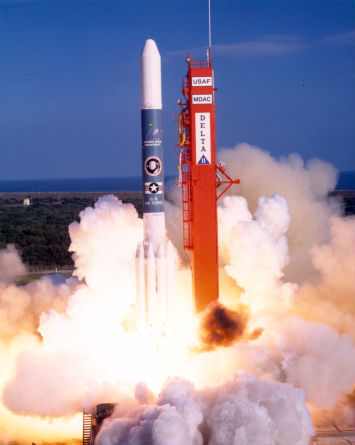DELTA 3000 SERIES FACT SHEET
By Cliff Lethbridge

Delta 3000 Series Launch, Photo Courtesy U.S. Air Force
Classification: Space Launch Vehicle
Length: 116 feet
Diameter: 8 feet
Date of First Cape Canaveral Launch: December 12, 1975
Date of Final Cape Canaveral Launch: March 24, 1989
Number of Cape Canaveral Launches: 33
The Delta 3000 Series was born out of the need for a rocket capable of carrying payloads too heavy for the Delta 2000 Series but not heavy enough to require the use of an Atlas-Centaur. Since NASA did not envision a need for a new medium-weight launch vehicle so close to the introduction of their Space Shuttle, the space agency was reluctant to provide financing for this next generation Delta rocket. However, NASA was able to provide a blessing for the vehicle, if not backed by up-front money. NASA did envision a use for the Delta 3000 Series as an interim launch vehicle to handle medium-weight payloads prior to operational flights of the Space Shuttle, which at the time were nearly a decade away. As a result, McDonnell Douglas was able to secure private industrial financing for the introduction of the Delta 3000 Series. NASA provided no research and development funding, but did purchase the completed vehicles in support of civilian and commercial satellite launches.
Although similar in basic design to the Delta 2000 Series, the Delta 3000 Series introduced larger, more powerful Castor solid rocket boosters. The improved solid rocket boosters were 36 feet, 5 inches tall and 3 feet, 4 inches wide, and could each produce a thrust of 84,000 pounds. The total package of nine improved solid rocket boosters increased the overall Delta 3000 Series vehicle thrust about 100,000 pounds over that of the comparable Delta 2000 Series rocket. Typically, five of the nine solid rocket boosters were ignited at liftoff. Along with the Rocketdyne first stage engine, a total thrust of 630,600 pounds was produced at launch. The remaining four solid rocket boosters were ignited following burnout and jettison of the first five.
In its original configuration, the three-stage Delta 3000 Series vehicle was capable of carrying a 2,100-pound payload to geostationary transfer orbit. A Payload Assist Module (PAM) was offered as an optional third stage in the Delta 3000 Series. The Thiokol PAM third stage motor, with a thrust of 13,000 pounds, allowed the total vehicle to carry a 2,300-pound payload to geostationary transfer orbit. This represented almost a 50 percent increase in payload capability over the Delta 2000 Series. An improved PAM, called PAM-D, was later introduced. It further increased the Delta 3000 Series payload capacity. Using the PAM-D third stage, the total vehicle was capable of carrying a 2,800-pound payload into geostationary transfer orbit.


